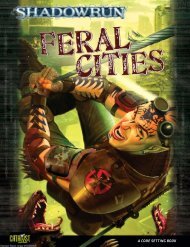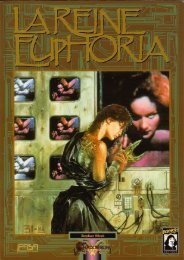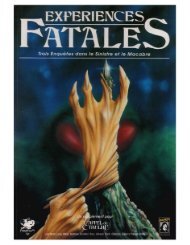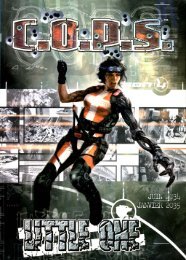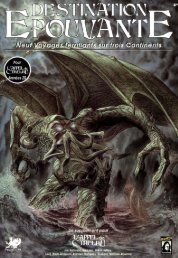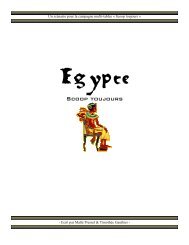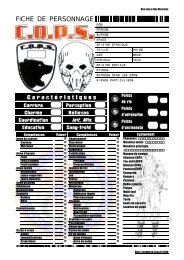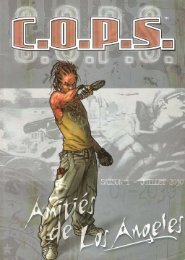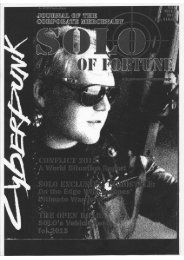Runner's Companion.pdf - Free
Runner's Companion.pdf - Free
Runner's Companion.pdf - Free
- No tags were found...
You also want an ePaper? Increase the reach of your titles
YUMPU automatically turns print PDFs into web optimized ePapers that Google loves.
Simon Wentworth (order #1132857) 9of natural immunity to magic and sorcery. Clinical tests suggestthat, while not totally immune, gnomes have proven to be moreresistant to the effects of magic. Studies and testing into the rootmechanism are ongoing and little is currently understood aboutthe phenomena.> I have it on good authority that the great dragon Schwartzkopf, lecturerat the University, has personal interest in the matter. Accordingto my source, the Benandanti have been looking for a link betweenthe geographic origins of the gnome subspecies and this mysteriousability with little success so far.> EthernautHarumenNative to the Indian subcontinent, harumen are a monkeylikelocal dwarf metavariant. While occurrences of this particularmetavariant date back almost to the Awakening, they often occurredin undeveloped and backwater areas of the subcontinentand were mistakenly identified as a type of sapient paracritter—and more recently as a changeling expression. Recent geneticmapping at Chennai University, however, offered incontrovertibleevidence that this is in fact a subspecies of dwarf apparently originatingfrom the southern reaches of the subcontinent.Less stocky and barrel-chested than the typical dwarf, harumenare far more agile and nimble than other pumillonis variantsand possess slightly elongated limbs. Named for their resemblanceto the ape god Hanuman, harumen also boast flattened noses, prehensiletails, and elongated feet and toes developed for climbing.While both tail and legs are profusely haired, the rest of their body(including the face) is not.Harumen enjoy a mixed reputation in the Union and neighboringcountries. While their association with the popular deityHanuman grants them a certain respect and reverence from thecommon Hindu, they are just as often seen as troublemakers,thrillseekers, and wildmen (as far as our studies suggest, unjustifiablyso). Their peculiar metatraits have also sparked a heateddebate among Hindus about the haruman’s place in the Wheelof Life and the rigid Hindu caste system. This relegates many toa social no-man’s land which they seek to escape by emigratingoutside the Union.Harumen are a minority variant even in India, where thedominant form is the basic metatype.TROLLSThe rarest of the metatypes, trolls (homo sapiens ingentis) arealso the least widespread of the metatypes. Not only are populationnumbers significant lower than the remaining metatypes, butsome areas of the globe and ethnic groups evidence below averageoccurrence of troll expression (for instance, among native SouthAmerican ethnicities) or none at all.Metavariants of the ingentis species are easily recognizable,given their sheer size, which stands out no matter how much theirappearance differs from the baseline metatype.An ingentis’s physique and often intimidating metatraits(such as horns, tusks, and significant dermal deposits) are one ofthe primary causes for social discrimination. Due to resemblanceof these metavariants to menacing creatures from mythology, theyRunner’s <strong>Companion</strong>are often more feared and subject to even more prejudice thannormal trolls.There are four recognized troll metavariants: cyclops, fomori,giants, and minotaurs.CyclopsA variant of Mediterranean trolls and native to the AegeanSea and Islands, a cyclops is often slightly larger and even moreheavily muscled than the average troll. However, evolutionaryadaptation to the warm climate and seabound environment ofthe Mediterranean archipelago grants most cyclops a bronzedskin, little body hair, and a lack of the metatype’s usual dermaldeposits.Cyclops typically possess only one horn and may have noneat all. Their identifying feature is the large single eye located inthe middle of their foreheads. While the bigger size of the eyeallows them to make reasonably accurate depth judgments basedon one-eyed (monocular) depth perception cues, cyclops lackbinocular vision cues (from two eyes), such as stereopsis and parallax(and therefore have inferior hand-eye coordination). Currentunderstanding of cyclopean neurophysiology indicates they evenlack the cerebral regions and neural wiring to process binocularcues—limiting the usefulness of ocular prosthetics.> Despite this lack of coordination, they are formidable opponentseven by troll standards though they are slow-witted, stubborn, andshort-tempered bastards. The Greek mobs are always eager to employthem as thugs and knee breakers.> 2XLToday, despite occasional racism, cyclops are seen in manysprawls around the Mediterranean from Barcelona, to Marseilleto Istanbul. Their hulking and intimidating presence and sheerphysical power mean they are in high demand as sailors, stevedores,security personnel, bouncers, and a number of other positionsfocusing on manual labor.One unexpected peculiarity detected by this study is thatcyclops register an unusual imbalance between male and femalesof almost three to one.FomoriFomori are a troll subspecies native to the British Isles.Several studies have established a tentative link betweenFomorian expression and Celtic family ancestry. If this is indeedthe case, it is likely that formori are not in fact native to the BritishIsles but rather the result of historical migration. While perhapsonce dominant, today the population seems to have diluted tothe point where fomori are on par with baseline trolls in demographics,with larger concentrations in Wales, Tir na nÓg and theSoutheast of Britain.Fomori are smaller than typical trolls and lack the extensivedermal bone deposits—this has earned them a misleading reputationas the “frail” cousins of the ingentis species when in fact theytend to be physically more powerful. In fact, fomori benefit frombeing less intimidating and comparatively more attractive toother metatypes and are statistically less likely to be targeted byracial prejudice. Both these factors facilitate social insertion and55alternative character concepts . . . . . . . . . . .



